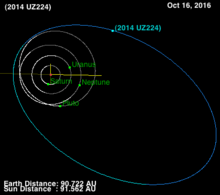astro.wikisort.org - Asteroid
2014 UZ224 is a trans-Neptunian object and possible dwarf planet orbiting in the scattered disc of the outermost Solar System. As of 2021[update], it is approximately 89.7 AU (13.42 billion km) from the Sun, and will slowly decrease in distance until it reaches its perihelion of 38 AU in 2142. The discoverers have nicknamed it "DeeDee" for "Distant Dwarf".[7][8]

 2014 UZ224 imaged by ALMA | |
| Discovery[1] | |
|---|---|
| Discovered by | David Gerdes et al. |
| Discovery site | Cerro Tololo Obs. |
| Discovery date | 19 August 2014 |
| Designations | |
MPC designation | 2014 UZ224 |
Alternative designations | DeeDee (nickname) |
Minor planet category | TNO[2] · SDO[3] p-DP[4] |
| Orbital characteristics[2] | |
| Epoch 31 May 2020 (JD 2459000.5) | |
| Uncertainty parameter 5 | |
| Observation arc | 12.08 yr (4,414 days) |
| Earliest precovery date | 15 October 2006[5] |
| Aphelion | 176.988±0.453 AU |
| Perihelion | 38.295±0.029 AU |
Semi-major axis | 107.642±0.275 AU |
| Eccentricity | 0.64423 |
Orbital period (sidereal) | 1116.81±4.28 yr (407,913 days) |
Mean anomaly | 320.482±0.210° |
Mean motion | 0° 0m 3.177s / day |
| Inclination | 26.790° |
Longitude of ascending node | 130.699±0.004° |
Time of perihelion | ≈ 27 May 2142[6] ±67 days |
Argument of perihelion | 29.989±0.063° |
| Physical characteristics | |
Mean diameter | 635+65 −72 km[3] |
Geometric albedo | 0.131+0.038 −0.028[3] |
Spectral type | G–R = 0.77±0.11[3] |
Apparent magnitude | 23.38±0.05[3] |
Absolute magnitude (H) | 3.5[3] · 3.4[2] |
2014 UZ224 was discovered by a team led by David Gerdes using data collected by the large camera Dark Energy Camera (DECam).[9][10] It has a diameter of ~635 km (395 mi) and reflects just 13 percent of the sunlight that hits it on its approximately 1,100 year orbit around the Sun.[3][2] Since the numbering of (532037) 2013 FY27 in May 2019, 2014 UZ224 may be the largest unnumbered object in the Solar System (though see 2012 VP113).[4] The earliest known precovery observations of 2014 UZ224 were taken at the Mauna Kea Observatory on 15 October 2006.[5]
See also
- List of Solar System objects most distant from the Sun
- List of Solar System objects by greatest aphelion
References
- "MPEC MPEC 2016-T104 : 2014 UZ224". IAU Minor Planet Center. 11 October 2016. Retrieved 11 October 2016. (K14UM4Z)
- "JPL Small-Body Database Browser: (2014 UZ224)" (last observation: 2018-11-15; arc: 4.24 years). Jet Propulsion Laboratory. Retrieved 11 October 2016.
- Gerdes, D. W.; Sako, M.; Hamilton, S.; Zhang, K.; Khain, T.; Becker, J. C.; et al. (April 2017). "Discovery and Physical Characterization of a Large Scattered Disk Object at 92 AU". The Astrophysical Journal Letters. 839 (1): 7. arXiv:1702.00731. Bibcode:2017ApJ...839L..15G. doi:10.3847/2041-8213/aa64d8. S2CID 35694455.
- Brown, M. (20 May 2019), How many dwarf planets are there in the outer solar system?, retrieved 1 June 2019
- "2014 UZ224". Minor Planet Center. International Astronomical Union. Retrieved 5 January 2021.
- JPL Horizons Observer Location: @sun (Perihelion occurs when deldot changes from negative to positive. Uncertainty in time of perihelion is 3-sigma.)
- "Soon you won't care about a newly discovered dwarf planet". Wired. 18 October 2016.
- "New dwarf planet solar system's 2nd most distant". Umich.edu.
- Cofield, Calla. "New Dwarf Planet Found in Our Solar System". Scientific American. Retrieved 12 October 2016.
- "A Friend for Pluto: Astronomers Find New Dwarf Planet in Our Solar System". NPR.org.
External links
- 2014 UZ224 ("DeeDee") Fact Sheet
- 2014 UZ224 at AstDyS-2, Asteroids—Dynamic Site
- 2014 UZ224 at the JPL Small-Body Database
На других языках
[de] 2014 UZ224
Vorlage:Infobox Asteroid/Wartung/SSD_ID keine Zahl- [en] 2014 UZ224
[ru] 2014 UZ224
2014 UZ224 — крупный транснептуновый объект в поясе Койпера, кандидат в карликовые планеты. Открыт группой астрономов в рамках проекта Pan-STARRS на снимках, полученных 19 августа 2014 года посредством камеры DECam телескопа имени Виктора Бланко в обсерватории Серро-Тололо в Чили[2][3]. Получил неформальное название DeeDee (сокращение от Distant Dwarf). Свет от DeeDee доходит до Земли за 13 часов. Объявление об открытии было опубликовано 11 октября 2016 года[4].Другой контент может иметь иную лицензию. Перед использованием материалов сайта WikiSort.org внимательно изучите правила лицензирования конкретных элементов наполнения сайта.
WikiSort.org - проект по пересортировке и дополнению контента Википедии